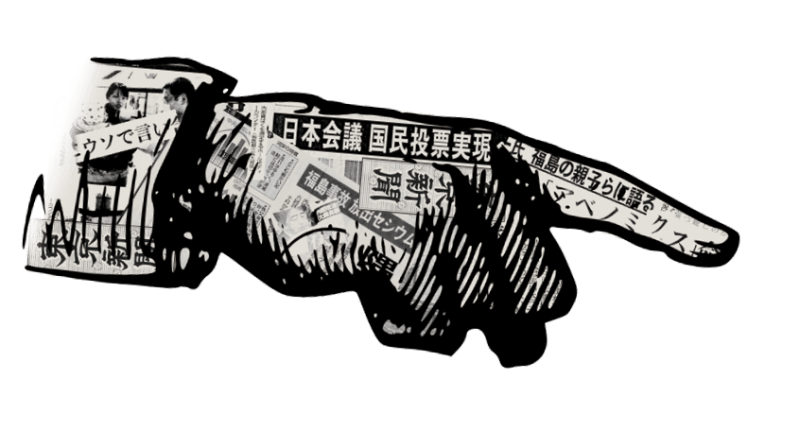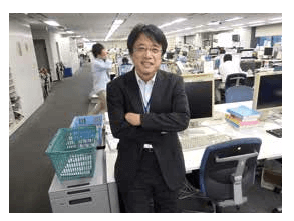Issue:

The FCCJ Freedom of the Press Award winning paper says its role is to be a watchdog on behalf of its readers.
The shopworn truism “truth is the first casualty of war” is often dusted off by reporters covering conflict zones, but rarely in peaceful, orderly Japan. Yet this was the phrase that Kengo Suganuma, chief editor of Tokyo Shimbun, reached for when he accepted an award last May for “publication of the year” from the FCCJ’s Freedom of the Press Committee.
Japan is “in a situation that is essentially a war on the truth” under the Liberal Democratic (LDP) led government, Suganuma told his audience. Though he didn’t cite examples, he was probably thinking about the attempt to neuter NHK, the nation’s most powerful broadcaster, by stuffing its board with conservative allies led by President Katsuto Momii, a friend of Prime Minister Shinzo Abe.
Then there was the LDP’s demand for “fair and neutral” reporting by the media during campaigning for last December’s general election; the bullying of critical shows such as NHK’s “Close Up Gendai,” the assiduous wining and dining of media bosses, the apparent strong arming of Asahi TV’s “Hodo Station” to dump political critic Shigeaki Koga; and the passage of the new state secrets law, which critics say is a blunt instrument for pummeling bureaucrats and journalists into toeing the official line.
To radical conservatives in the Abe camp, these are all simply attempts to recalibrate the “left leaning” media. At a junior LDP lawmakers’ study session at LDP headquarters on June 25, some of the attendees urged a further step. Blaming the media for the public’s “lack of understanding” about the government’s security legislation, they proposed leaning on advertisers to smother negative media coverage and “smash” Okinawa’s two leading newspapers.
In this struggle for ideological turf, Tokyo Shimbun is hardly as embattled as its much larger national rival, Asahi Shimbun, which has lost hundreds of thousands of readers since admitting reporting errors last year, but it too has taken flak from nationalists angry at its anti government, “left leaning” coverage. That’s a description Suganuma emphatically rejects.
“We don’t think of ourselves as ‘left’ or ‘right,’” he says during an interview at the company’s offices overlooking Hibiya Park. “We think of what we do as monitoring power, looking at the powerful from the position of the bottom, or from the perspective of people with no power.” Newspapers should be watchdogs on behalf of readers, he adds. “We’re not ‘anti Abe’ we’re just doing our job.”
A shift in priorities
Suganuma dates the shift in his newspaper’s priorities to the Fukushima nuclear crisis, when it earned a reputation for independent reporting and scrutinizing official claims. He compares 2011 to Japan’s wartime era, when military dispatches (daihonei happyo) lying about the doomed war effort were carried word for word in the national media. “Throughout the war, newspapers reported exactly what they were told and that’s why the war went the way it did,” he says.
The newspaper’s approach since then has been straightfor ward, says its editor. “We try to tell things as they are,” even if it upsets people in power. The same strategy animates its reporting of the government’s security bills, the American base issue on Okinawa and the secrecy law, which it firmly opposed (Japan’s most read newspaper, the Yomiuri Shimbun, backed it).
On nuclear issues, it has consistently taken a more critical line than its rivals. In April it scooped them with a story obtained via the information disclosure law about how the foreign ministry had secretly simulated an attack on a nuclear power plant that would likely kill 18,000 people from radiation poisoning. The report predicted that the attack would cut power to the plant, triggering a meltdown and hydrogen explosions roughly what occurred in Fukushima.
The newspaper covers the bitter dispute over replacing Futenma Air Station on Okinawa more extensively than its much wealthier national rivals. “Tokyo based newspapers don’t give a voice to people in Okinawa,” he explains. “It’s the same with Fukushima, Article 9 of the Constitution and other issues. If you look at it from that perspective, we are for the position of ordinary people, not the powerful. We want people to not give in to intimidation and keep challenging power.”
Tokyo Shimbun’s relative independence is partly thanks to its regional roots. As part of the Chunichi group, headquartered in Nagoya, it has traditionally had less access to the halls of power in Nagatacho and Kasumigaseki, says Tatsuro Hanada, a media specialist at Waseda University. That gives it a different viewpoint than the obsessive Diet watchers in its national rivals and the press clubs on which they so heavily rely.
“The national media tend to spend a lot of time in the corridors of government and report on what they’re doing,” agrees Koichi Nakano, a political scientist at Sophia University. “Tokyo Shimbun does less of that so it’s less good at covering what the government is up to, but better at reporting society and social issues.” Thus, much of its coverage since the return of the LDP government in late 2012 has been on the sometimes ugly impact of Abenomics, the economic creed named after the prime minister, rather than its political and economic nuts and bolts.
Tokyo Shimbun is also one of the very few Japanese publications to tackle the influence of Nippon Kaigi, perhaps Japan’s most powerful right wing political lobby. The group has over 230 local chapters, 38,000 fee paying members and a network that reaches deep into Nagatacho. About a third of the Diet and over half the 19 member Cabinet are members of the group’s parliamentary league. Prime Minister Abe is the group’s “special advisor.”
Given this hefty firepower, it is “absolutely normal” to write about Nippon Kaigi, says Suganuma. But he is reluctant to speculate on why it is considered journalistically off limits by his newspaper’s rivals. He says political reporters, paradoxically, don’t have a lot of interest in covering the group because they’re too busy reporting the daily machinations of the Diet. Tokyo Shimbun’s report on Nippon Kaigi was researched and written by a team of roving reporters.
Division in the newspaper market
Tokyo Shimbun cannot hope to match the clout of the liberal Asahi Shimbun. Its morning circulation of roughly 500,000 is a fraction of the Asahi’s 7.2 million, and about a third of the Sankei Shimbun, the national newspaper on the other end of Japan’s political spectrum. Still, its post Fukushima penchant for poking a stick in the eye of the powerful has earned it new fans. Indeed, activists have formed a support group to increase its subscriptions.
Suganuma says circulation is slowly declining but claims his newspaper has picked up 10,000 - 20,000 new readers every year since the 2011 disaster. Many are in their 40s or 50s and some had given up reading newspapers for years, or had never read one at all, he says. “Of course we’ve lost people too, as older readers pass away, but we’re encouraged by this growth.” In these straitened times, it helps that the newspaper is slightly cheaper too about ¥3,350 per month as opposed to ¥3,950 for the Asahi.

photo by DAVID McNEILL
All this is happening against a difficult background for newspapers. General daily circulation in Japan fell by over 4 million over the decade to 2013, according to the Japan Newspaper Publishers and Editors Association. Tokyo Shimbun is doing better than most, says Hanada. “I think the newspaper’s change was not only an editorial policy but a market led policy,” he says. “Since the decline of the Asahi began, I have heard many people say they would like to change to the Tokyo Shimbun.”
This relative success is part of the post Fukushima polarization of the Japanese newspaper market, explains Kaori Hayashi, another media specialist at the University of Tokyo. “This phenomenon was triggered first by debates over the use of nuclear energy. But since then, we see the market being divided: Yomiuri, Sankei, the Nikkei and NHK on the right, and the Asahi, the Mainichi and Tokyo Shimbun on the left.”
“This division can be seen over the entire national agen da Okinawa, the Constitution and politics in East Asia,” she continues. Hayashi says Suganuma’s newspaper appeals to liberal intellectuals in Tokyo, particularly because its opinionated approach is very different from the “conventional, rather arid style of Japanese journalism.” The Asahi used to enjoy this position, she says, before it began pulling its punches.
The backlash against Tokyo Shimbun’s editorial policy has been fairly light. The radical right seems to have concentrated, instead, on bringing down the hated Asahi. One of Japan’s largest ever lawsuits has been launched against the liberal flag ship and conservative politicians have discussed plans to haul Asahi editors and journalists before the Diet.
By contrast, Tokyo Shimbun has escaped relatively unscathed, says Suganuma, though he laments how official sources have dwindled under the Abe regime. “Someone in the government has told sources not to talk to us,” he says. “Information goes instead to the Yomiuri and the Sankei.”
Unlike television, he says, newspapers are lightly regulated. In effect, print holds the line on press freedom. “The media is definitely going in the wrong direction,” he says. “Over the last four years, we seem to be going back to the wartime era, when the media was not reporting what was really happening. We want to revive its role of really telling the truth.”
David McNeill writes for the Independent, the Economist, the Chronicle of Higher Education and other publications. He has been based in Tokyo since 2000.

